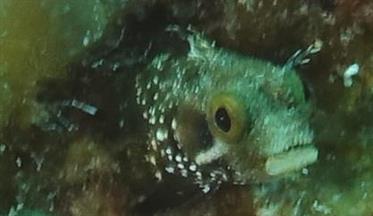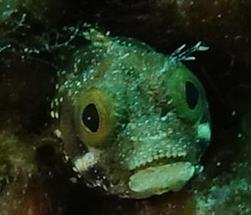



Acanthemblemaria spinosa
| Ecological Descriptors | ||||
| Habitat | Size (cm) | Diet | Behaviour | Sex |
| Co | 3 | Pla | I/ Colonial | F |
Description:
Snout and jaws often white (occasionally green/ yellow brown). Body brown to black with pale spots and patches, but usually occluded from view in the tube. Numerous compact, short papillae on head giving "crewcut" appearance...papillae of equal length unlike Secretary Blenny (A. maria). Cirri above eyes may be branched, but not bushy. Yellow-green "goggle" eyes.
Ecology
This species is reef-associated, typically on small patch reefs surrounded by white sand. Lives in tubes/ holes in coral, vacant serpulid worms etc and may form colonies. Found to 18 m (59 ft). Observed primarily on coral. Males found more frequently than females in the vacated constructed tubes of serpulid worms or vermetid molluscs that provided greater surface for egg deposition.
Usually only seen with head protuding from refuge as it filters zooplankton.
Juveniles settle into small crevices until a hole can be found. Individuals are stratified by size, with larger individuals occurring higher up off the reef. Below a certain minimal density, new individuals will not join a colony. It appears that there must be a minimum number of individuals.
Distributions on a reef appear to be strongly food limited, where higher local abundances are possible in areas with large currents and available zooplankton. The species mainly feeds on calanoid copepods
Life Cycle
Males believed to guard eggs in their tube. Little known on the reproductive aspect of this species. Demersal spawners; depositing eggs in pre-prepared nest. Masculinity is reflected in terms of superiority of holes, and as such, males try to acquire ideal holes to attract females. Upon selection of holes, characteristically deep, a female will lay eggs and males fertilize them. Males guard these eggs until they hatch into
larvae.
Snout and jaws often white (occasionally green/ yellow brown). Body brown to black with pale spots and patches, but usually occluded from view in the tube. Numerous compact, short papillae on head giving "crewcut" appearance...papillae of equal length unlike Secretary Blenny (A. maria). Cirri above eyes may be branched, but not bushy. Yellow-green "goggle" eyes.
Ecology
This species is reef-associated, typically on small patch reefs surrounded by white sand. Lives in tubes/ holes in coral, vacant serpulid worms etc and may form colonies. Found to 18 m (59 ft). Observed primarily on coral. Males found more frequently than females in the vacated constructed tubes of serpulid worms or vermetid molluscs that provided greater surface for egg deposition.
Usually only seen with head protuding from refuge as it filters zooplankton.
Juveniles settle into small crevices until a hole can be found. Individuals are stratified by size, with larger individuals occurring higher up off the reef. Below a certain minimal density, new individuals will not join a colony. It appears that there must be a minimum number of individuals.
Distributions on a reef appear to be strongly food limited, where higher local abundances are possible in areas with large currents and available zooplankton. The species mainly feeds on calanoid copepods
Life Cycle
Males believed to guard eggs in their tube. Little known on the reproductive aspect of this species. Demersal spawners; depositing eggs in pre-prepared nest. Masculinity is reflected in terms of superiority of holes, and as such, males try to acquire ideal holes to attract females. Upon selection of holes, characteristically deep, a female will lay eggs and males fertilize them. Males guard these eggs until they hatch into
larvae.
Spinyhead Blenny

Spinyhead Blenny


140

139



